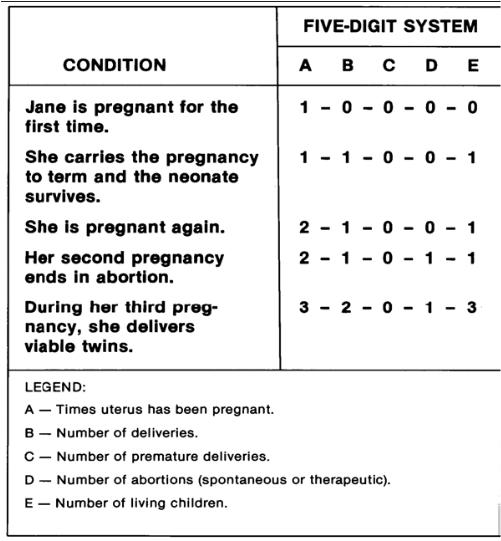This is the Archived Desktop Edition.
You should be transferred to the Newest Edition for Desktop and Mobile within 2 seconds.
|
Lesson 3: Diagnosis of Pregnancy
Many changes occur in a woman's body during pregnancy. These changes, although most apparent in the reproductive organs, involve other body systems as well. Weeks may pass before the female realizes she has become pregnant or she may learn upon a visit to a doctor for other reasons. Confirmation of her pregnancy is most important for both the mother and the fetus. It is then when she can begin receiving medical care for the health and welfare of herself and the baby. In this lesson, we will cover key definitions and present presumptive, probable, and positive signs of pregnancy along with tests used to determine pregnancy.
a. Gravida. A pregnant woman. This refers to any pregnancy regardless of duration.
b. Para. A woman who has delivered a viable young (not necessarily living at birth). Para is used with numerals to designate the number of pregnancies that have resulted in the birth of a viable offspring (see para 3-3).
c. Nulligravida. A woman who has never been pregnant.
d. Nullipara. A woman who has not delivered a child who reached viability.
e. Primigravida. A woman pregnant for the first time.
f. Primipara. A woman who has delivered one child after the age of viability.
g. Multigravida. A woman who has been pregnant more than once.
h. Multipara. A woman who has delivered two or more fetuses past the age of viability. It does not matter whether they are born dead or alive.
i. Grandmultipara. A woman who has had six or more births past the age of viability.
j. Viability. Refers to the capability of a fetus to survive outside the uterus after the earliest gestational age (approximately 22 to 23 weeks gestation).
k. In utero. Refers to within the uterus.
In referring back to the definitions in paragraph 3-2, the information is abbreviated as parity/gravidity. For example, "0/1" means that a woman has not carried a pregnancy to viability (nullipara) and is pregnant for the first time (primigravida).
Table 3-1 below shows parity and gravidity using a five-digit system:
|
The Brookside Associates Medical Education Division is dedicated to the development and dissemination of medical information that may be useful to medical professionals and those in training to become medical professionals. This website is privately-held and not connected to any governmental agency. The views expressed here are those of the authors, and unless otherwise noted, do not necessarily reflect the views of the Brookside Associates, Ltd., any governmental or private organizations. All writings, discussions, and publications on this website are unclassified.
© 2007 Medical Education Division, Brookside Associates, Ltd. All rights reserved
